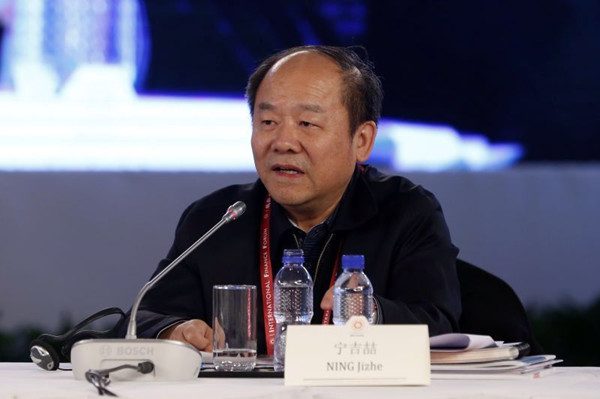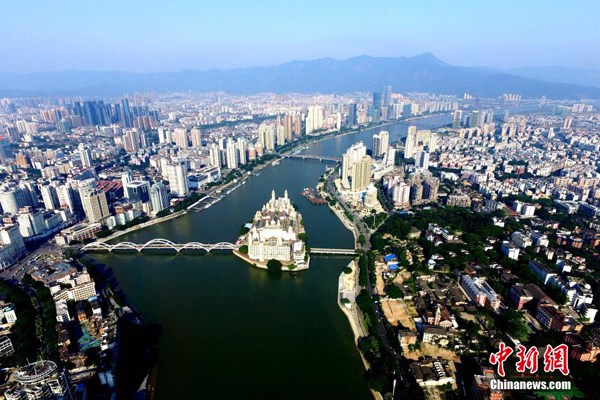(ECNS) – China's 13th Five Year plan, an important blueprint that maps out how the world's second largest economy will be in five years, might be a hard read for many. Here are 10 highlights of the plan, explained by Ning Jizhe, deputy director of China's Reform and Development Commission, and one of the 84 people who participated in drafting the plan.
Ning made the speech at the 2015 annual meeting of the International Finance Forum in Beijing on November 7.

1. China will maintain medium-high growth
Although no numerical targets were offered in the plan, President Xi Jinping wrote in a later statement that an annual growth rate of at least 6.5 percent would be required for China to "build a moderately prosperous society" by 2020.
"This is a very important target," Ning said. "The GDP and per capita income will double by 2020 from 2010."
As the Chinese economy enters a "new normal," its growth rate fell to 6.9 percent in Q3 2015, down from over 7 percent for more than a decade.
2. Focus will shift to quality of growth
China says it tolerates a growth rate below 7 percent, as its economy is transforming from an investment-driven to consumption-driven model, according to Ning.
"Consumption accounts for over 50 percent of GDP growth, and the service industry has contributed to more than half of China's GDP, which is good news for China's structural adjustment," Ning said.
The state-directed, investment-driven growth paradigm has contributed to rapid industrialization, but also given rise to mounting debts, repayment pressure, overcapacity in some traditional manufacturing sectors, and pollution.
3. China will further cut red tape
"We'll push forward reforms, promote new technology, new models of economic development and new industries," Ning said. "We will also trim administrative procedures to facilitate such new sectors and models."
Earlier this year, the country unveiled a plan, dubbed "Made in China 2025," to upgrade its manufacturing while encouraging new technology and innovation.
4. More money is to go to public service
"China will increase input in education, health, sanitation, environment and infrastructure in rural and mid-west areas," Ning said, adding that the government will invite public investment in areas such as water, railway, electricity and environment.
Although China is known for its high-speed railways, the rural and mid-west areas lag behind in infrastructure development. In June alone, the Reform and Development Commission allocated more than 100 billion yuan to two railway projects in the inland areas.
5. Coordinating international initiatives with regional development
Domestically, China has issued plans to develop the areas around its capital Beijing, the Yangtze River delta, the Pearl River delta, the industrial provinces in northeast, and the FTZs. Internationally, it launched the One Belt One Road Initiative.
It should coordinate the development of these areas and efforts at home and abroad for concerted growth, Ning said.

6. 70 million people will be lifted out of poverty
"Seventy million people in China live on less than one dollar per day, and these people will be lifted out of poverty by 2020," Ning said.
He also mentioned expanding the social security program and reducing the income disparity between urban and rural residents. In 2014, urban and rural per capita disposal incomes were 28,844 yuan ($4,542) and 10,489 yuan ($1,652) respectively, according to the National Bureau of Statistics.
7. China pursues green growth
The new development plan has put environmental protection at the top of the agenda, such as cutting emissions, pollution reduction, development of new energy, and green industries, according to Ning.
8. Consumers are encouraged to buy more
Consumption in China accounted for 50.2 percent of China's GDP in 2014. The figure is above 80 percent in developed countries.
"There's huge potential to tap," Ning said. "People in the United States consumed $13 trillion in 2014, while the Chinese consumed only $5 trillion."
China has long been a saving country. The Chinese put aside over 50 percent of their money in piggy banks, according to statistics. China's RMB deposit reached nearly 114 trillion yuan ($18 trillion) in 2014, and Chinese people's per capita savings are two to three times higher than their American counterparts.
9. Let 200 million people have urban residency
China wants to help 200 million rural people get city residency, Ning said, adding that this will unleash a potentially large pool of labor and boost spending in cities.
10. China wants to further open up to the rest of the world
"This includes encouraging imports and service trade, such as outbound tourism and overseas spending," Ning said.
In 2014, more than 100 million Chinese traveled overseas, spending an average of 8,175 yuan ($1,287), according to travel website qyer.com.
While China welcomes foreign money, it also encourages investment in overseas countries.
In 2014, China's overseas investment amounted to $102.9 billion, a year-on-year increase of 14.1 percent, according to China News Service. Foreign investment in China was $119.6 billion in 2014.


















































